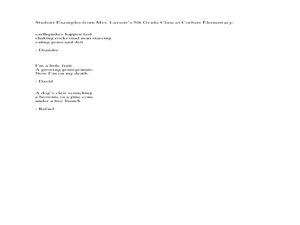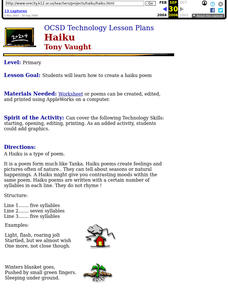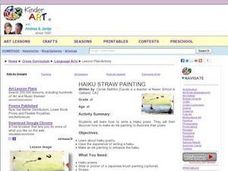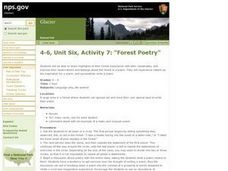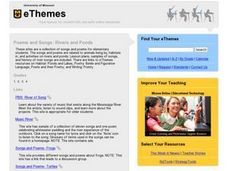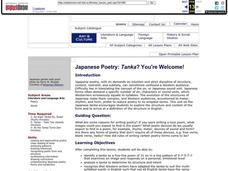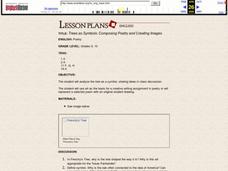Curated OER
Do You Haiku? We Do!
Third graders try their hands at writing Haiku, a form of Japanese poetry. Haiku is usually 17 syllables in three-line form. This engaging lesson has many excellent worksheets and website imbedded in the plan. They share their finished...
Curated OER
Creating and Presenting Haiku with Kid Pix
Third graders research what a Haiku is and be able to answer related questions on an example of a Haiku. They create an original Haiku of their own using general Haiku characteristic guidelines. Students use Kid Pix to type in and...
Curated OER
Do You Haiku?
After examining several Haiku and noting characteristics of the form, class members create five of their own poems. Use this resource for extra practice or review.
Curated OER
Take a Breath, Steal Some Time
Students explore the art of haiku's by listening to, modeling and creating them. In this haiku poetry lesson, students choose an object to focus their haiku on. After hearing a brief history of the haiku; students make...
Curated OER
Video Haiku
Students write Haiku poetry and illustrate their poems with a form of digital or video technology. In this poetry and technology lesson plan, students study examples of haiku poetry and then write their own poem. Students use digital...
Curated OER
Writing
Students write poems and a narrative story. In this writing instructional activity, students read stories and poems written by other students and read examples of haiku's and diamonte's. Students write an acrostic poem and a...
Curated OER
Haiku
Students discuss haiku poems and how they are written with a certain number of syllables in each line. They look at examples and then write their own haiku poems and publish them on the computer.
Curated OER
What Is Haiku
Students engage in a lesson that is concerned with the study of poetry while focusing on Haiku as a format. They practice reading a variety of different pieces of literature in order to increase exposure. Students discuss the author's...
Curated OER
Haiku
Sixth graders study Haiku. In this Haiku instructional activity, 6th graders explore the history of the poetry form. Students also examine the structure the Japanese poetry as they read examples. Students write their one Haiku.
Curated OER
Haiku Straw Painting
Students explore haiku poetry, have the experience of writing a haiku, and make an ink painting to enhance the haiku.
Curated OER
Writer's Notebook and Haiku
Students, after viewing various examples from students around the world, as well as writing in their Writer's Notebook, create, compose and revise a Haiku poem that sketches a "snapshot" or image in time. They incorporate the theme or...
Curated OER
Forest Poetry
Learners explore nature by participating in a poetry writing activity. In this forest investigation instructional activity, students identify images and feelings they experienced while they were in a forest on a class trip. Learners...
Curated OER
Poetry to the Core
Second graders examine several examples of poetry in the six lessons of this unit. The lessons focus on five poetic forms, couplets, quatrains, limericks, Haiku, and free verse.
Curated OER
Poems and Songs: Rivers and Ponds
Students explore songs and poems related to the animals, habitats, and activities on rivers and ponds. They listen to song clips, explore various websites, read poems and song lyrics, complete worksheets, and define key vocabulary words.
Curated OER
Unrhythmic, Culturally Diverse, Simple Forms of Poetry
Students write an example of each of the three poetry styles (haiku, cinquain, and diamante) and they see that not all poetry rhymes.
Curated OER
Japanese Poetry: Tanka? You're Welcome!
Students explore the structure and content of the Tanka form and to arrive at a definition of the structure in English. They analyze a tanka to determine its structure and intent and compose two Tanka; one in traditional form and one...
Curated OER
Show Don't Tell
Students review the Show Don't Tell method of writing haiku poetry. They practice distinguishing poetic language from academic language and create poems based on images, not explanations.
Curated OER
Two Haiku
Eighth graders, in pairs, discuss what they already know about Haiku poetry. They try to remember the rules, history, and focus of traditional Japanese Haiku. they read more examples of Haiku and then write and illustrate their own...
Curated OER
Personalized Poetry Portfolio
Eighth graders create their own poetry portfolio containing poems that relate to Students' lives and families. The portfolio consist of the following types of poems: acrostic, diamante`, haiku, cinquain, and free verse.
Curated OER
Poetry Pop-Up
Third graders, after exploring the process of writing poetry through imagery words that go beyond pen and paper, create a Poetry Pop-Up Book. They incorporate the use of the Thesaurus and clip-art/digital photography to assist them in...
Curated OER
Raptor Poetry
Students create poems about raptors. They discuss raptors and create three poems including at least two of the following: haiku, diamante, found, and acrostic. They create a classroom book of poems or conduct a poetry slam where students...
Curated OER
The Relationship Between Zen And Haiku Aesthetics
Students examine the principles of Haiku as they relate to idealss found in Zen Buddhism in this High School lesson. The lesson concludes with the creation of individual haikus by each student.
Curated OER
Five Simple Poems
Students listen as the teacher explains what poetry is as well as describes several types of poetry such as haiku, free verse, limerick, cinquain, and an acrostic. Students read examples of each type of poetry. They compose a poem...
Curated OER
Trees as Symbols: Composing Poetry and Creating Images
Learners analyze the tree as a symbol, sharing ideas in class discussion. They use art as the basis for a creative writing assignment in poetry or represent a selected poem with an original student drawing.



